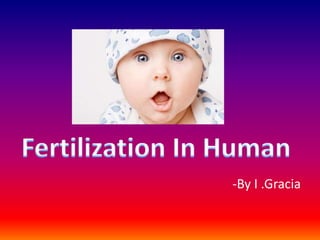
Fertilisation in human Being
- 2. The formation of the sperm in male and the ovum in female is called gametogenesis. It involves spermatogenesis(formation of spermatozoa) and oogenesis(the formation of ova). Gametes with haploid cells are produced through gametogenesis
- 3. The spermatozoan consists of head, a middle piece and tail. The sperm head is elongated and formed by the condensation of nucleus. The anterior portion has a cap like structure called acrosome. It contains hyaluronidase an enzyme that helps the sperm to enter the ovum during fertilization. A short neck connects the head and middle piece which comprises the centrioles.The middle piece contains the mitochondria which provides energy for the movement of tail. It brings about sperm motility which is essential for fertilization.
- 4. The mature ovum or egg is spherical in shape. The ovum is almost free of yolk. It contains abundant cytoplasm and the nucleus. The ovum is surrounded by three membranes. The plasma membrane is surrounded by inner thin zona pellucida and an outer thick corona radiata. The corona radiata is formed of follicle cells. The membrane forming the surface layer of the ovum is called vitelline membrane. The fluid-filled space between zona pellucida and the surface of the egg is called perivitelline space.
- 5. The reproductive system in both males and females becomes functional and an increase in sex hormone production resulting in puberty. This phenomenon tends to start earlier in females than in males. Generally boys attain puberty between the age of 13 to 14 years, while girls reach puberty between 11 to 13 years. In male, the onset of puberty is triggered by the secretion of the hormone testosterone in the testes, in female the secretion of estrogens and progesterone from the ovary. The secretion of both male and female hormones are under the control of the pituitary gonadotropins luteinizing hormone (LH) and follicle stimulating hormone (FSH)
- 6. The cyclic events that take place in a rhythmic fashion during the reproductive period of a woman’s life is called menstrual cycle. In human females the menstrual cycle starts at the age of 11-13 years which marks the onset of puberty and is called menarche, and ceases around 48-50 years of age and this stage is termed menopause. The reproductive period is marked by characteristic events repeated almost every month in physiologically normal women (28 days with minor variation) in the form of a menstrual flow.
- 7. The menstrual cycle consists of 4 phases
- 8. . . •Fertilization in human is internal and occurs in the oviduct of the female genital tract. It takes place usually in the ampulla of the fallopian tube. An oocyte is alive for about 24 hours after it is released from the follicle. Fertilisation must take place within 24 hours. The sperm enters into the ovum and fuses with it, resulting in the formation of a ‘zygote’. This process is called fertilization. The zygote is a fertilized ovum. Fertilizat ion •The first cleavage takes place about 30 hours after fertilization. Cleavage is a series of rapid mitotic divisions of the zygote to form many celled blastula (Blastocyst) which comprises an outer layer of smaller cells and inner mass of larger cells Cleavage and Formation of Blastula •The blastocyst (fertilized egg) reaches the uterus and gets implanted in the uterus. The process of attachment of the blastocyst to the uterine wall (endometrium) is called implantation. The fertilized egg becomes implanted in about 6 to 7 days after fertilization Implantat ion
- 10. • The transformation of blastula into gastrula and the formation of primary germ layers(ectoderm, mesoderm and endoderm) by rearrangement of the cells is called gastrulation. This takes place after the process of implantation from cleavage to blastocyst formation Gastrulation • The establishment of the germ layers namely ectoderm, mesoderm and endoderm initiates the final phase of embryonic development. During organogenesis the various organs of the foetus are established from the different germ layers attaining a functional state. Organogenesis • The placenta is a disc shaped structure attached to the uterine wall and is a temporary association between the developing embryo and maternal tissues. It allows the exchange of food materials, diffusion of oxygen, excretion of nitrogenous wastes and elimination of carbon dioxide. A cord containing blood vessels that connects the placenta with the foetus is called the umbilical cord Formation of Placenta
- 11. Pregnancy (Gestation) Parturition (Child Birth) h • It is the time period during which the embryo attains its development in the uterus. Normally gestation period of human last for about 280 days. During pregnancy the uterus expands upto 500 times of its normal size. Pregnancy • Parturition is the expulsionof young one from the mother’s uterus at the end of gestation. Oxytocin from the posterior pituitary stimulates the uterine contractions and provides force to expel the baby from the uterus, causing birth. • The ejection of milkis stimulated by posterior pituitary hormone oxytocin. • The milk produced from the breast during the first 2 to 3 days after child birth is called colostrum. It contains immune substances and provides immunity to the new born which is essential for the body. Parturition